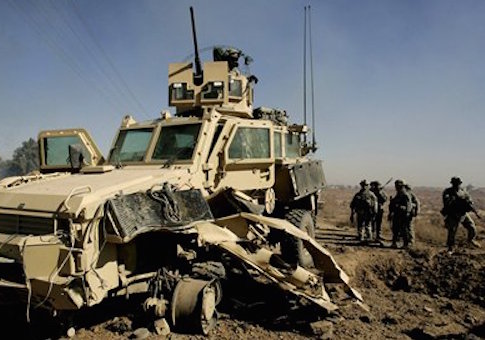At a time when the U.S. Army is grossly cutting back, military officials are struggling to fund projects to fight electronic warfare.
Breaking Defense reported that the Army is nearly a decade away from reaching what the chief of electronic warfare on the Army’s Pentagon staff Col. Jeffrey Church labeled the "next level" in the fight against electronic military capabilities.
While the Army currently has more than 32,000 defensive jammers to hinder roadside bombs, it will not be able to fully develop an offensive jammer and streamline the Multi-Function Electronic Warfare system (MFEW) until 2023 largely because of restricted resources.
"Can that be accelerated? Yes," Church alleged, admitting, however, that "there’s no money tree" because of the sequester and related cutbacks.
"I have doctrine. I have people. I have facilities," Church explained of his ability to create a "robust electronic warfare program" for the Army. "What we lack is the materiel."
"If you go to a unit today in the Army and you say, let me see your ‘electronic warfare equipment,’ and you go to the EWO (Electronic Warfare Officer) and he opens up his wall locker, it’s empty," the officer said, despite the fact that he deemed electronic warfare capability crucial to the Army. "Right now the Army relies on borrowing assets from other people."
Though the Pentagon’s fiscal year 2016 budget assigns $2.5 million to the Electronic Warfare Planning & Management Tool, a software that will give electronic warfare troops the ability to collect data from sensors, Church explained that there is currently no machinery that can serve as the source from which to gather the data to analyze an electromagnetic battlefield.
The Multi-Function Electronic Warfare system, which is comprised of a network of both sensors and jammers, would present a solution, though it’s currently a mere "concept" in development stages and has not yet become a formal requirement in the Army, according to Church.
In order to receive funding, MFEW needs to become a program of record. The program isn’t scheduled to be in service until 2023 and will not have full capability until 2027.
"Guys like the Russians, guys like the Chinese, their surrogates, they’ve spent the last 20 years continuing the development and acquisition of an electronic warfare capability, whereas ... the Army got out of the business," admitted Church.
Earlier this month, news broke that the Army plans to cut 40,000 troops and lay off 17,000 civilian employees over the next two years even as the Islamic State (IS, also known as ISIS or ISIL) surges in the Middle East.
Should sequestration begin in October, the losses will be even more dramatic, as the Army will have to cut an additional 30,000 troops. Such cuts would prevent the Army from meeting current deployments and regional demands.
